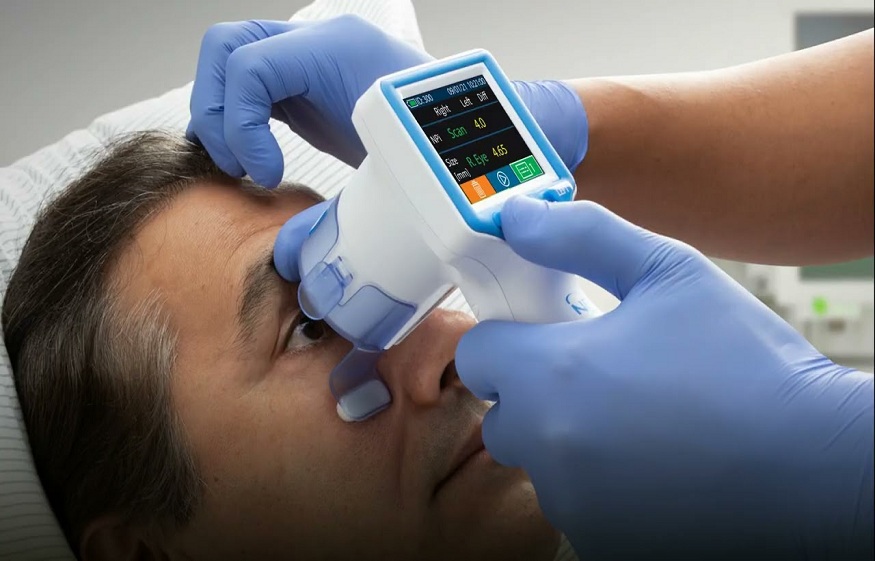In the fast-paced world of medical technology, innovation often happens quietly behind the scenes. The recent release of the NPi Pupillometer by NeurOptics represents one such development that promises to shake up the vital but overlooked practice of pupillary examination.
This device aims to transform clinicians’ evaluation of pupillary light reflex by harnessing cutting-edge optics and stimulus delivery techniques. Given the far-reaching diagnostic and research applications of precise pupil measurement, the NPi Pupillometer’s arrival heralds an exciting new chapter in the pupillary assessment space.
The Evolution of Pupil Assessment Tools
Doctors have used crude pupil assessment techniques like swinging flashlights and eyeballing responses for decades. However, such methods’ inherent subjectivity and variability limit their usefulness for diagnosis.
The development of basic pupillometers improved matters somewhat, yet their imprecision and limited capabilities left much to be desired. The NPi Pupillometer aims to eliminate these issues through its cutting-edge design.
Why the Innovative NPi Pupillometer is a Game Changer
By leveraging the latest optical technologies and neuroscience insights, the NPi Pupillometer aims to deliver unprecedented analytical power and precision to pupillary testing. This ingenious device monitors pupillary response parameters across multiple lighting conditions, including size, latency, constriction, and dilation velocities. Its sensitive infrared optics accurately resolve minute changes as small as 0.03 mm, while adjustable stimulus delivery isolates the effects of light levels, colors, and patterns on pupil function.
The NPi Pupillometer condenses the entire pupillary reflex examination into an automated, standardized sequence completed in under a minute. Streamlined workflows and an intuitive touchscreen interface help minimize training requirements and measurement errors. Backed by validation studies, this system promises to raise the bar on reliability and sensitivity compared to earlier pupillometry tools and subjective assessments.
Technical Capabilities to Quantify Pupil Function
This compact, lightweight unit utilizes high-resolution infrared optics and a 5-megapixel image sensor to accurately measure pupil diameter across a 0.5 to 9 mm range. Optimized on-axis illumination minimizes variability caused by positioning. The device calibrates input lighting levels before each test to isolate the effects of its programmable light stimulus. Doctors can adjust settings to deliver stimuli of varying intensity (0 to 1000 lux), color, duration, and modulation pattern to probe the pupillary reflex.
Automated sequences walk users through pre-programmed testing protocols, including repeated light flashes, oscillating stimuli, and customized parametric tests. The system’s responsive touchscreen interface allows for inputting patient data and reviewing results. Test measurements can be transferred via USB, Ethernet, or WiFi for further analysis and integration into patient medical records.
Benefits to the Medical Community
By enabling rigorously controlled pupillary measurements, the NPi Pupillometer stands poised to elevate the value of pupil testing for enhancing patient care. Its capacity to quantify subtle pupillary deficits can aid early disease detection and allow tracking of treatment responses. The device simplifies screening for traumatic brain injury, concussion, neurological illnesses like Alzheimer’s, and more.
The NPi Pupillometer also promises to accelerate research into new pupillometric biomarkers and pharmacological agents. Its ability to capture high-resolution pupillary reflex data creates opportunities to discern novel relationships between pupil function and health. Researchers are already applying it to explore topics ranging from migraines and opioid effects to elucidating autonomic dysfunction in cardiac patients.
Navigating Practical Hurdles to Widespread Adoption
Of course, realizing the NPi Pupillometer’s full potential hinges on addressing real-world implementation barriers. The device’s roughly $4,000 price tag, while justifiable given the technology, may deter adoption, especially in resource-limited settings.
Training requirements pose another obstacle, though the device’s intuitive interface aims to minimize the learning curve. Some also worry that reliance on pupillometry could lead clinicians to undervalue traditional pupillary size measurement methods, which provide complementary neurological insights.
However, the NPi team focuses on education and training to ease integration into clinical practice. Ongoing research to further validate the technology against manual methods and demonstrate patient benefits will likely accelerate uptake. Ultimately, the device’s unparalleled utility for augmenting neuro exams outweighs concerns.
Conclusion:
The NPi pupilometer is more than a fleeting novelty; it’s the dawn of a new era in pupil assessment. Its introduction signifies a paradigm shift and heralds a future where technology and human expertise coalesce. As we stand at this pivotal juncture, one thing is evident: the future of pupil assessment, with tools like the NPi Pupillometer leading the charge, is bright, promising, and poised for continued evolution.




